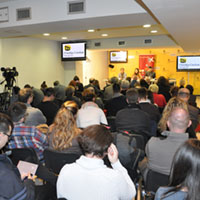Unpunished Concealment of more than 900 Bodies in Mass Graves in Serbia
 On Tuesday, January 31st, 2017, the HLC presented its eighth dossier in a row about unprosecuted crimes and possiblel perpetrators. The Dossier “The cover-up of evidence of crimes during the war in Kosovo: Concealment of Bodies Operation” shows how the operation of concealing the bodies of Albanians killed during the war in Kosovo in 1999 was planned and executed, and which civilian, military and police institutions were involved in it. The objective of the Dossier is to point to the perpetrators of the concealment of one of the most serious crimes in Kosovo, to enable the citizens of Serbia to hear about the crimes committed in their name, and to encourage witnesses to come out with their knowledge about these events and help the search for the more than a thousand bodies of Albanian civilians who were killed during the conflict in Kosovo and who are still reported as missing.
On Tuesday, January 31st, 2017, the HLC presented its eighth dossier in a row about unprosecuted crimes and possiblel perpetrators. The Dossier “The cover-up of evidence of crimes during the war in Kosovo: Concealment of Bodies Operation” shows how the operation of concealing the bodies of Albanians killed during the war in Kosovo in 1999 was planned and executed, and which civilian, military and police institutions were involved in it. The objective of the Dossier is to point to the perpetrators of the concealment of one of the most serious crimes in Kosovo, to enable the citizens of Serbia to hear about the crimes committed in their name, and to encourage witnesses to come out with their knowledge about these events and help the search for the more than a thousand bodies of Albanian civilians who were killed during the conflict in Kosovo and who are still reported as missing.
Four locations with mass graves concealing 941 bodies of Albanians killed in Kosovo in the period from March 24th until late May 1999, have been found on the territory of the Republic of Serbia to date. The victims were mainly unarmed men, but also women and children, who were killed in more than 25 different crimes committed by Serbian forces in Kosovo. Today, 122 victims of these particular crimes are still reported as missing, and there is a reasonable suspicion that their bodies are still concealed in mass graves on the territory of Serbia.
The HLC Legal Programme Director, Ms. Milica Kostić, stated that the main objective of the concealment of bodies of Albanian civilians was to cover-up the crimes and thus prevent criminal investigation, and that it was planned at the highest government level and involved almost the entire state apparatus. The names of 110 persons who were involved in the crimes are given in the Dossier, as well as an abundance of evidence, which is valuable for initiating first criminal proceedings before the courts in Serbia, including for the concealment of bodies of the killed Albanians at secret locations in Serbia.
Ms. Kostić also reminded the public that Serbia is a signatory of the regional Missing Persons Declaration, which foresees priority prosecution of crimes in which victims have disappeared, but that despite this fact, no one has ever been prosecuted in Serbia for the concealment of bodies in mass graves. The lack of real will for the search for the missing is also visible in the attempt to conceal the archives of the relevant state bodies, thus obstructing access to the information of public importance relevant for the reconstruction of the events from the past. Without a doubt, persons who were involved in the commission of these crimes and who are still working in Serbian institutions, are obstructing the prosecution of the individuals responsible and an efficient search for the missing.
Finally, Ms. Kostić reminded the audience that, after more than one decade since the first mass grave sites were discovered in Serbia, there is still no memorial marking the suffering of the victims whose bodies were found inside them. The HLC initiative for erecting a memorial to victims whose bodies were found in the mass graves in Batajnica represents an isolated example of an attempt to rectify this injustice.
A researcher at the HLC and one of the authors of the Dossier, Mr. Nemanja Stjepanović, reminded those present that what preceded the Concealment of Bodies Operation was a letter from the ICTY Chief Prosecutor, in which she warned all the officials of the Federal Republic of Yugoslavia (FRY) and Serbia that all individuals responsible for the violence in Kosovo would be criminally prosecuted. Following this letter, the Concealment of Bodies Operation was planned, in three meetings involving the President of the FRY, Slobodan Milošević, the Police Minister Vlajko Stojiljković, the Head of the State Security Department Radomir Marković, the Head of the Public Security Department Vlastimir Đorđević, and other officials from the MUP and probably the Yugoslav Army.
The logistics of the MUP and public utility companies was used for the concealment of bodies, and a great number of police officers, members of the territorial defence units, civil protection units and state-owned companies, participated in this operation. One of the participants in this operation, who is today the President of the Association of MUP Retirees, Mr. Vladimir Aleksić, has recently publicly demanded an acknowledgement of responsibility by all members of the police who have acted in violation of the law. Another participant in the operation was Goran Radosavljević (“Guri”), who is a member of the Main Board of the ruling Serbian Progressive Party, and who was responsible for the training at the Petrovo Selo Training Center at the time when the bodies were buried at this location in two mass graves.
The Army was also involved in the transfer of bodies. The previously published Dossiers “Rudnica” and “Operation Reka” contain evidence of this, whilst this Dossier on the cover-up of crimes during the war in Kosovo presents new evidence about the events which have been described in the previous Dossiers, but also on the removal of bodies from other locations.
Mr. Stjepanović concludes that the fact that the majority of the participants in the removal of bodies operation have never been subject to criminal investigation speaks volumes about the wide-spread impunity for war crimes in Serbia. This is accompanied by the lack of interest in the fate of the remaining Albanians who were killed and whose bodies have not yet been found, and for their families who have been waiting for years for the bodies of their closest family members to be handed over to them.
Mr. Bekim Blakaj, from the Humanitarian Law Center Kosovo, reminded the public of the recently published data referring to the human losses, according to which 13,535 persons were either killed or disappeared in relation to the war in Kosovo, whilst 1,659 persons are still registered as missing. Family members of the missing have been trying for 16 years now to exercise their right to truth, justice and reparation, but have failed, since neither the state authorities in Kosovo nor those in Serbia have put enough effort into discovering the truth about the victims’ suffering and the locations where their bodies have been concealed.
Mr. Blakaj noted that the families of the missing were particularly vulnerable immediately after the end of the war, when mass graves had not yet been discovered and most of the families still believed that their closest family members could still be alive. Owing to that, they were susceptible to fraud and, as will become apparent, gave huge amounts of money for false information about the fate of their missing family members. Because of the long-lasting agony of victims’ families, one should not be surprised by the words articulated by a young man who had found his brother’s remains in Batajnica, that the happiest day of his life was the day when he found his brother’s body and found out about his fate.
Finally, while certain representatives of associations of victims have complained that Albanian victims are being the subject of discussion in Belgrade and Serbia, Ms. Bosiljka Radovanović from Đakovica, whose husband and brother were killed in front of their family house, used this opportunity to remind all of the persons attending the Presentation, of the situation which existed before the war and of the life of Serbs and Albanians who used to live together and in peace. She also stated that she has had an opportunity to experience this relationship even today, on the rare occasions when she goes to visit her past home in Đakovica.

















